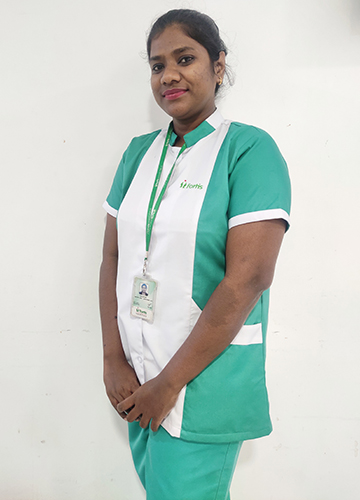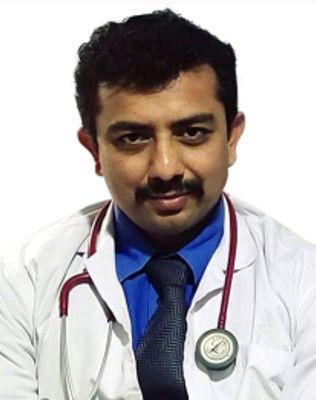The pandemic has struck fear into our hearts. Dolly A.S., a nursing educator at Fortis Hospital, Cunningham Road, Bengaluru, is part of the emergency medicine team and feels her fears are reasonable. However, she does not shy away from doing what is expected of her. “In cases where the patient needs urgent medical attention, we do not wait for the Covid negative report to start treatment. Saving lives is the biggest priority for us,” says Dolly, 31. “Recently, one of our doctors had a cardiac arrest and was brought to the ER. He tested positive later. By then, a lot of our staff had been exposed to him. That way, it is a lot riskier than working in the ICU.”
A Covid frontline warrior, Dolly ensures her colleagues are well protected and encourages them to care for Covid patients. “We identified the protocols for handling Covid patients. Now, with unwavering dedication, everyone in the emergency department (ED) is ready to take care of them.”
Dolly may find a kindred spirit in Dr Sandeep Gore, director of emergency medicine at Fortis Hospital, Mulund, Mumbai. Gore has been on his toes ever since the pandemic began.
A few hours before we spoke to Gore, a patient with severe lung damage caused by Covid-19 was brought to the ED. Then came another one with septic shock, a severe infection that causes a drop in blood pressure and multiple-organ failure. The third patient he attended to was an accident victim with multiple injuries, followed by someone suffering a massive heart attack. “All of them survived. It was a perfect day,” says Gore, for whom a hectic schedule like this is common.
For Gore, nothing is more gratifying than giving a patient a new lease on life. “One of our patients had acute stroke and he was paralysed,” says Gore. Stroke happens when the blood flow to the brain is obstructed. “We dissolved the obstruction using thrombolytics (clot-busting drugs) and ensured the blood flow was restored. Right diagnosis at the right time followed by the right intervention is crucial in saving lives and limbs. However, not everyone may get it during the pandemic,” says Gore, who is also the national vice-president of the Society for Emergency Medicine in India.
The ED specialises in acute medical care of patients with varying disease conditions ranging from stroke to heart attack and lung damage to poisoning and trauma. It is in the ED that patients are stabilised, evaluated, diagnosed and, if necessary, shifted to other departments after making further management plans. Emergency doctors and staff should have updated knowledge, the right skills to deliver emergency care and good communication skills. Infrastructure and equipment like ventilators, monitors and point-of-care ultrasound machines are also a prerequisite for emergency care.
During the pandemic, the EDs were overwhelmed with the influx of Covid patients. Meanwhile, many non-Covid-19 patients succumbed to death as they avoided seeking care over the fear of contracting Covid-19, or were denied admission. “Mixing of Covid suspects with other patients was invariably happening in spite of all efforts,” says Dr Sumedh Jajoo, associate professor, department of medicine, Mahatma Gandhi Institute of Medical Sciences, Sevagram, Maharashtra. “Many non-Covid patients acquired Covid during hospital stay because of suboptimal precautions for such patients. Poor infection control practices led to many hospital-acquired infections during the pandemic.”
Travel restrictions during the lockdown affected access to hospitals and, in turn, led to many preventable deaths. “The pandemic caused a sudden drop in ED visits and hospitalisations of non-Covid patients during the lockdown, and a concurrent increase in out-of-hospital mortality mainly driven by deaths due to cancers and cardiovascular and chronic kidney diseases,” Dr Manish Srivastava, head of department, accident and emergency, Aditya Birla Memorial Hospital, Pune. “Because of fear of Covid-19, patients started avoiding hospital visits leading to exacerbation of their medical problems. Even patients with acute medical or surgical problems started avoiding hospital visits for emergency care.”
At his hospital, new protocols were implemented in the emergency department. “Three zones in emergency, one for non-communicable disease, one for communicable disease and a zone for isolation were added to the infrastructure which ensured that other emergency patients of trauma could also get a bed during the pandemic,” says Srivastava. PPE kits and regular sanitisation were made mandatory and there was also the incorporation of new tech like telemedicine and AI in the emergency care system.
The pandemic was a wake-up call for the Central government. It showed how inadequate access to emergency care remained a major problem even in cities. Realising this, the government mandated all medical colleges to have an ED with at least 30 beds.
It makes Gore hopeful, but not complacent. Emergency care in India needs big reforms, he says. There is an unmet need for trained emergency physicians all over the country, in rural as well as urban areas. “When compared with the standards in the UK, the US and Singapore, India needs a minimum of 1,32,000 emergency medicine doctors. We don’t even fulfil 5 per cent of the requirement. Meanwhile, India continues to be the biggest exporter of doctors, including trained emergency medicine doctors, to the west,” he says. “Unless we stop brain drain and develop a well-equipped emergency care system, our ambitious rural health care projects like Ayushman Bharat will not succeed.”
“Indian emergency departments are evolving,” says Dr Shailesh Shetty S., consultant, emergency medicine, Aster CMI Hospital, Bengaluru. “Since this speciality is quite new, there is a lack of trained personnel. The large cities have already started understanding the need for this and are constantly working on this.”
Handling death is one of the most difficult tasks for an emergency physician, he says. “Especially when deaths occur within the first few minutes to hours of arrival or if they have been brought in dead. There are legal requirements, too, which need to be taken care of,” he says.
Burnout is an inevitable part of the job, says Dr Sushant Chhabra, head of emergency medicine at Manipal Hospitals, Dwarka, Delhi. “It occurs due to the heavy patient load. Long working hours mean less family time. Normally I work for nine hours. During the second wave of Covid-19, I put in more than 12 hours a day,” he says.
The job involves clinical challenges as well. “You will have only limited information regarding the patient,” says Chhabra. “Based on that and some point-of-care tests, you have to make a diagnosis. You may not have the luxury of running a series of tests on the dying patient. So, you have to make a decision using your clinical skills and intuition.”
Chhabra lost some of his patients during the pandemic. “Over the years of my training and working in emergency medicine, I have made myself emotionally strong,” he says. “I do have empathy for my patients. But I don’t get emotionally connected to them. If I do, I would not be able to take care of the next patient. If I feel a patient is not going to survive, I talk to his attendants and help them cope.” Over time, he has learnt how to respond to angry attendants. “Nobody wishes to come to an ED by choice. Patients and their relatives may be anxious and upset. As an emergency medicine specialist, you may have to deal with all sorts of emotions.”
The pandemic strained EDs. However, it has had some positive effects, too. New protocols have been brought in. “Covid-19 patients were categorised into three—mild, moderate and severe—based on guidelines issued by the government,” says Dr Maheshwar Lal, consultant and head of emergency, PSRI Hospital, New Delhi.
The ED at the Asian Institute of Medical Sciences in Faridabad had separate wings to treat Covid and non-Covid patients during the first wave. The second wave was more devastating. “This time around, on the same floor we created different wings for Covid and non-Covid patients,” says Dr Satish Chaku, associate director, emergency services, Asian Institute of Medical Sciences.
Most of the emergency patients the hospital received in the last few months were those who had developed Covid-related complications. “A large number of them were in need of hardcore critical care,” says Chaku. “In fact, all the available emergency beds in the hospital at any given time during the pandemic were always occupied, leaving a lot of patients that could not be accommodated for definitive care.”
Ashish Kumar Sharma from Rishikesh considers himself lucky. He was running a fever of 104°C when the second wave was at its peak and people were struggling to find hospital beds. “I took Dolo for four days but the temperature did not come down. Finally, I went to a hospital. I was diagnosed with Covid. My chest CT score was 16/25,” says Sharma, 43, who works with an export company in Delhi. As the fever persisted, he was rushed to the ED at Asian Institute of Medical Sciences. “The hospital had just one bed available then,” he says. The timely emergency care that he received kept him alive. “Everyone around me was dying,” recalls Sharma. It is hard for him to get rid of those memories and sometimes he just tells himself it was a bad dream.




